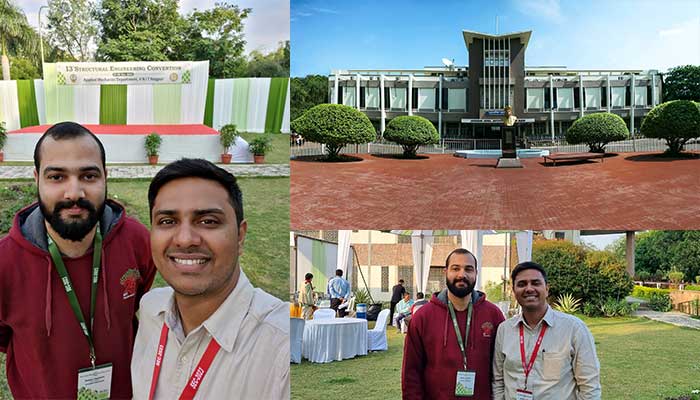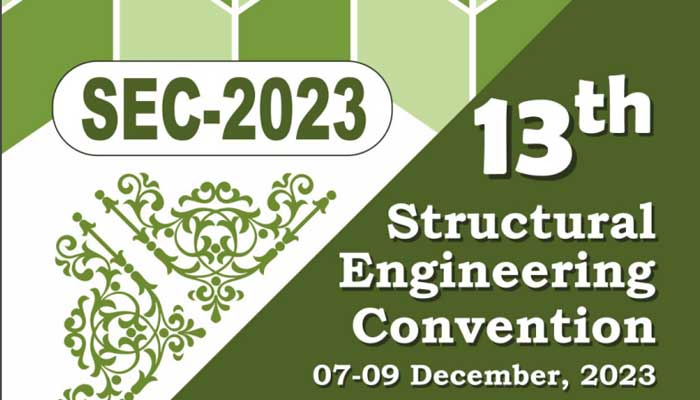Dr. P Pravin Kumar Venkat Rao and his Ph.D student Rohan Vashisht presented 4 papers on Historical Masonry materials and Systems at the 13th Structural Engineering Convention (SEC-2023) organised by the Department of Applied Mechanics, Visvesvaraya National Institute of Technology (VNIT) Nagpur from 7 to 9 December. The papers are:
- An Overview of Masonry Material Properties for Historical Buildings. Here is the summary of the paper as explained by the authors:
Masonry is a traditional, extremely durable type of construction material, and many heritage masonry structures from different historical eras have endured adverse environmental conditions to varying degrees despite sometimes significantly losing their integrity, strength, and durability. Throughout history, the choice of masonry materials has largely been determined by availability, local geological formations, and environmental conditions. Although masonry has evolved over the centuries, the fundamentals of using stone, aggregate, or brick in combination with a binding material have not changed. It is not surprising that strong masonry materials were used to build some of the most notable historical buildings in human history that are still standing today. Resources nowadays are devoted to heritage architecture restoration and conservation because of its cultural significance. For the proper selection of construction techniques that could be applied to structural restoration or before taking any remedial action, a thorough understanding of masonry materials is required. Architectural surveys, the use of written evidence, laboratory investigations, and on-site tests can all be used to achieve this. Hence, the current study provides a thorough overview of the materials and their mechanical properties that have been developed over more than five thousand years for the construction of different structural components of masonry buildings that helped perform well during past seismic events.
- A Review on Construction Techniques and Structural Restoration of Ancient Masonry Buildings. Here is the summary of the paper as explained by the authors:
In the whole procedure of preservation, conservation, and restoration of monuments and historical buildings, structural restoration is considered an undesirable parameter, since it implies interventions on a large scale that might harm the authenticity of a culturally protected building. However, this type of intervention is an inevitable action, because it pertains to the safety of the building and, most importantly, to the safety of the users. In this respect, authenticity and safety are two concepts contradicting each other, and they are ensured by professionals of different origins and philosophies, namely archaeology & architecture on one side and science & technology on the other. In the case of structural restoration, these professionals are required to find a common space of co-existence so that the results of restoration satisfy both concepts, authenticity and safety. The present study gives an overview of thorough knowledge of construction techniques of masonry elements or systems or forms used in the past. In fact, in a period of more than five millennia, various techniques of construction have been developed as a result of big revolutions that have taken place in the history of human civilization. A deep knowledge of all the above is necessary for the suitable selection of present-day techniques and materials that might be used in structural restoration, where principles of reversible or irreversible techniques play a vital role together with the compatibility and durability of intervention materials. The main objective of this study is to guide the structural engineers involved in the structural repair of ancient monuments and buildings of national importance.
- Structural Behaviour of Masonry Systems in Monumental Buildings: An Outline. Here is the summary of the paper as explained by the authors:
Masonry structures cover a very wide range of monumental works in space and time, covering almost 6,000 years. The structural assessment of the load-carrying capacity of such old structures depends on several parameters such as: (a) material strength; (b) texture of the structure; (c) geometrical form and dimensions; (d) existing loading and constraints; and (e) expected loadings at failure. Detailed calculations are also required for the structural evaluation using most of the above parameters firstly by considering the gravity loads and secondly by the combination of gravity load and lateral action in areas of high seismicity. However, at the same time, it is equally significant for the structural engineer, who is involved in structural restoration design, to know in depth qualitatively the basic forms and their structural behaviour of monumental buildings. The structural engineer in charge must understand from the beginning, qualitatively, the structural behaviour of a building under consideration to various basic actions so that one can make a preliminary diagnosis of the causes that are responsible for the existing damages (cracks, drifts, settlements, splitting etc.). In this way, one will be in a position to focus on the detailed research, in situ and laboratory, to the critical points of the building, and can conduct the analysis and design using suitable models for a credible safety evaluation. Therefore, an effort is made in the present study to give a qualitative approach to the structural behaviour of the basic structural forms of masonry monumental and historical buildings, where the consequences of the seismic action are traumatic now and then. This article gives an outline and creates background information for further structural evaluation of the monuments.
- Building Materials for Repair and Strengthening of Monuments: A Review. Here is the summary of the paper as explained by the authors:
Monuments were built for thousands of years as the most enduring and well-known representations of past civilizations. It is crucial to preserve these because they are national symbols with unique cultural and historical significance. The deterioration of the structures happens as a result of weathering, fire, natural disasters like earthquakes, construction flaws, and numerous other factors. In general, the issue with repairing and reinforcing regular buildings is very different from the issue with restoring monument buildings. The goal of keeping a monumental structure in use may be viewed as secondary in importance and any event as a result of the effort made to fulfil the main task. In the case of monumental buildings, emphasis is placed on the preservation of their aesthetic and historical aspects. Therefore, the restoration strives to protect and highlight the monument’s or building’s aesthetic and historical aspects. Choosing the appropriate material for the restoration depends on how the original structure looks. New materials must be compatible with those already used in the building. The goal of the present study is to provide an overview of the materials used to restore the structural integrity of historic structures and monuments that have been damaged by seismic activity. All of these buildings need extra attention because of their specific historical or architectural value, or because they are significant because they are still standing examples of a former way of life.

December 2023

